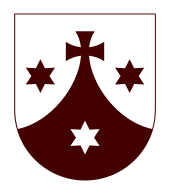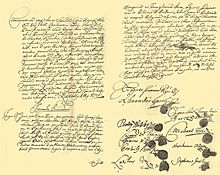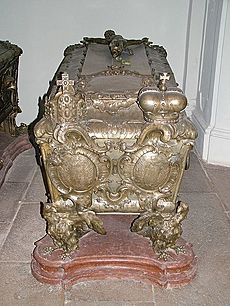Eleonore Magdalene of Neuburg facts for kids
Quick facts for kids Eleonore Magdalene of Neuburg |
|||||
|---|---|---|---|---|---|
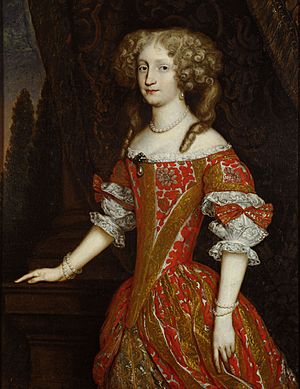
Portrait by an unknown artist, c. 1680
|
|||||
| Holy Roman Empress (more...) | |||||
| Tenure | 14 December 1676 – 5 May 1705 | ||||
| Coronation | 19 January 1690 | ||||
| Born | 6 January 1655 Düsseldorf, Holy Roman Empire |
||||
| Died | 19 January 1720 (aged 65) Hofburg Palace, Vienna, Austria |
||||
| Burial | Herzgruft (heart) Imperial Crypt (body) |
||||
| Spouse | |||||
| Issue |
|
||||
|
|||||
| House | Wittelsbach | ||||
| Father | Philip William, Elector Palatine | ||||
| Mother | Elisabeth Amalie of Hesse-Darmstadt | ||||
| Religion | Roman Catholicism | ||||
Eleonore Magdalene of Neuburg (born 6 January 1655 – died 19 January 1720) was a princess from the House of Wittelsbach. She became Holy Roman Empress, German Queen, Archduchess of Austria, Queen of Hungary, and Bohemia. She was the third wife of Emperor Leopold I.
Before her marriage and after her husband's death, Eleonore lived a very religious life. She even translated the Bible from Latin to German. She was known as one of the smartest and most virtuous women of her time. Eleonore was involved in political matters during the reigns of her husband and sons. This included managing court money and foreign relations. In 1711, she served as a temporary ruler for a few months. During this time, she signed the Treaty of Szatmár. This treaty recognized her family's right to the throne of Hungary.
Contents
Eleonore's Early Life
Eleonore was born in Düsseldorf, which was part of the Holy Roman Empire, on 6 January 1655. She was the oldest of 17 children. Her parents were Philip William, Count Palatine of Neuburg, and his second wife, Elisabeth Amalie of Hesse-Darmstadt.
Soon after her birth, she was baptized Eleonore Magdalene Therese. A Jesuit poet named Jakob Balde wrote a poem for her. He later became her spiritual teacher. In August, her family moved from Düsseldorf to Neuburg.
Eleonore grew up in a very religious home and received an excellent education. She was good at understanding finances and literature. She also knew a lot about theology (the study of religion). She could speak Latin, German, French, and Italian very well. She enjoyed art and hunting. But her favorite thing was reading and translating religious books into German.
From a young age, Eleonore was very devout and committed to Catholicism. She often participated in religious activities. She also visited sick people every day. She believed that all people were equally important to God. Because of this, she asked poor people to treat her like an ordinary person, not a royal.
Marriage Plans
Eleonore had a strong desire to become a nun in the Carmelite order. She even provided special support to Carmelite monasteries. However, her parents did not allow her to become a nun. Five different kings asked to marry her, but Eleonore refused them all. One of these was James, Duke of York, who later became King of England and Scotland. He proposed to her in 1671.
In April 1676, Leopold I, Holy Roman Emperor lost his second wife. He quickly began looking for a new wife because he needed a male heir. His previous marriages had produced six children, but only his oldest daughter, Archduchess Maria Antonia, survived.
Eleonore was chosen as a potential wife for the Emperor. Her father worked hard to gain support for this marriage. Some people at the Imperial court spread rumors that Eleonore was not healthy or attractive. However, these rumors did not stop the Emperor. He needed an heir and knew Eleonore's family was known for having many children. Her father also showed Leopold I a special portrait of Eleonore.
Marriage talks began in April 1676. An envoy from Eleonore's father went to Vienna. He gained the support of Empress Dowager Eleonora Gonzaga, who was Leopold I's stepmother. The Emperor's personal doctor examined Eleonore in Neuburg. He confirmed she was healthy. Leopold I made his final decision about the marriage in October. Eleonore was not happy about becoming Empress, as she still wanted to be a nun. But she accepted her parents' wishes.
The official engagement happened on 25 November 1676. Eleonore was 21, and Leopold was 36. They were second cousins, so Pope Innocent XI gave special permission for them to marry. Eleonore's dowry (money or property brought by a bride to her husband) was set at 100,000 florins. Leopold I and Eleonore met two days before the wedding and liked each other.
Empress and Queen
The wedding took place in Passau on 14 December 1676. It was a grand ceremony, and celebrations lasted for several days. As a wedding gift, Leopold gave Eleonore the famous Wittelsbach Diamond. On 7 January 1677, the Imperial couple arrived in Vienna.
Eleonore quickly became pregnant. She gave birth to ten children in total. Six of them lived to adulthood:
- Joseph (born 1678 – died 1711), who became Emperor Joseph I after his father.
- Maria Christina Josepha (born and died 1679).
- Maria Elisabeth (born 1680 – died 1741), who became Governor of the Austrian Netherlands.
- Leopold Joseph (born 1682 – died 1684).
- Maria Anna (born 1683 – died 1754), who married King John V of Portugal.
- Maria Theresia (born 1684 – died 1696).
- Charles (born 1685 – died 1740), who became Emperor Charles VI after his older brother. He was the last male ruler from the House of Habsburg and was the father of the famous Empress Maria Theresa.
- Maria Josepha (born 1687 – died 1703).
- Maria Magdalena (born 1689 – died 1743).
- Maria Margaretha Magdalena (born 1690 – died 1691).
Eleonore faced many challenges as Empress. In 1679, an outbreak of plague forced the Imperial family to leave Vienna. They moved to Mariazell and then Prague, but the disease reached those places too. Also, a peasant uprising in Bohemia made the Empress and her children flee to Linz Castle.
Another danger was the constant threat from the Ottoman Empire. In July 1683, the Imperial family again left Vienna for Passau because of the Turks. In September of that year, the Turks suffered a major defeat near Vienna in the Battle of Vienna.
Because of these events, Eleonore was not crowned immediately after her marriage. On 9 December 1681, she was crowned Queen of Hungary in Pressburg. In 1685, her father became Elector Palatine. On 19 January 1690, she was crowned Holy Roman Empress at Augsburg Cathedral. She was pregnant with her last child at the time. She traveled with her husband and personally oversaw her children's education.
Eleonore's Political Role
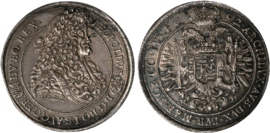
Eleonore was politically active and had a lot of influence over her husband. It was said that she would receive and open important political documents. Her husband, Leopold I, would wait beside her like a secretary.
As Empress, Eleonore took charge of the imperial court's economy. She managed to reduce its expenses by organizing things better. She always paid great attention to charity. The imperial revenue (income) became large enough to build hospitals, orphanages, and convents. She also supported many religious groups, churches, and monasteries.
Since she spoke many languages, Eleonore translated foreign political documents for her husband. Many were written in French. She built many connections by helping people and granting favors. She supported the career of Chancellor Theodor Strattmann. She also recommended Jesuits Bauer and Tönnemann as advisers to the Emperor. In 1686, she brought back the Order of the Starry Cross. This order was started by her stepmother-in-law, Eleonora Gonzaga.
Eleonore looked out for her own family's interests. She arranged important marriages for her sisters. She also helped her younger brothers in their church careers. She arranged the marriages of both her sons.
Life at Court
Empress Eleonore was seen as performing her duties well. She followed the strict Spanish court rules used in Vienna. Her court was influenced by her strong religious beliefs. It was very strict, simple, and quiet, almost like a convent. All religious holidays and rules were strictly followed. Some courtiers said it felt like "an atmosphere of eternal mourning."
Eleonore took part in shooting matches and hunting parties. She also performed religious duties. From 1688, she spent a lot of time on the Marian cult (devotion to the Virgin Mary). She introduced her two daughters-in-law to it. She was an active member of a religious group devoted to the Virgin Mary. This group required daily religious practice and charity. In 1688, she received the Sternkreuzorden. The imperial couple also visited the Shrine of Our Lady of Altötting. A special image of the Virgin Mary from Pötsch, known as the "Weeping Madonna," was brought by them. It was placed in St. Stephen's Cathedral, Vienna. On 9 May 1684, the Empress received the Golden Rose from Pope Innocent XI.
Empress Mother
During Joseph I's Reign
Emperor Leopold I died in 1705. Her eldest son, Joseph I, became the new Emperor. After her husband's death, Eleonore wore mourning clothes for the rest of her life. During Joseph I's reign, she tried to keep her political influence. She had a difficult relationship with her daughter-in-law, Wilhelmine Amalia of Brunswick-Lüneburg. Eleonore arranged her son Charles's marriage. She oversaw the Catholic education of his bride, Elisabeth Christine of Brunswick-Wolfenbüttel. She took her on a pilgrimage in 1706 before the marriage in 1707.
Eleonore as Regent
In 1711, Emperor Joseph I died. His younger brother Charles, who was in Spain at the time, became the new ruler of the Habsburg lands. Eleonore was appointed as the temporary ruler (Regent) of the Habsburg lands. This happened while Charles traveled from Barcelona to Vienna. Her daughters supported her in this role.
Eleonore's regency was quite successful. After negotiations, she signed the Treaty of Szatmár. This treaty recognized the rule of the House of Habsburg in the Kingdom of Hungary. She congratulated the successful diplomat Alexander Károlyi by making him a general.
During Charles VI's Reign
During the reign of Charles VI, Eleonore and her daughter-in-law Wilhelmine Amalia were involved in discussions about who would inherit the throne. This was for Joseph I's daughters. A secret agreement from 1703, called the Mutual Pact of Succession, said that if both brothers died without sons, the elder brother's daughters would have priority over the younger brother's daughters. This meant Joseph's eldest daughter would inherit the Habsburg thrones.
This secret pact was known only to Leopold I, his sons, and Count Johann Friedrich von Seilern und Aspang. Eleonore and her daughters-in-law did not know for sure if the document existed. But they had heard about it. Both were very active in finding out the truth and asking Charles to make a public succession order. In 1712, Wilhelmine Amalia managed to get the document. She sent it to her family's head, George Louis, Elector. He sent Gottfried Wilhelm Leibniz to help her negotiate with Charles VI for her daughters' rights.
When Charles VI presented the original version of the Pactum Mutuae Successionis on 21 April 1713, Wilhelmine Amalia had succeeded in making him recognize the secret succession order of 1703. However, Wilhelmine Amalia's success was short-lived. A few days before, on 19 April, Charles VI had already secretly announced his wish to change the Pact. He wanted his own future daughters to have priority over his nieces.
In 1719, Charles VI was forced to arrest his maternal aunt and cousin, Hedwig Elisabeth, Princess Sobieski and Maria Clementina Sobieska. This was to stop the marriage between Maria Clementina and James Francis Edward Stuart. However, Eleonore managed to delay the arrest warrant for some time. Her relatives were eventually arrested in Innsbrück. Eleonore continued to use her connections to prevent Charles from marrying Maria Clementina to someone else. She eventually helped her niece escape from Austria to Italy.
Last Years
In her last years, Eleonore lived a very religious life, almost like a nun. In her will, she asked her servants not to tell anyone about her strict religious practices. On 1 January 1720, Eleonore suffered a stroke. This left the right side of her body paralyzed. She received the Anointing of the Sick and gave her blessings to her children and grandchildren. They gathered at her bedside. During her final days, Eleonore was cared for by her two daughters-in-law, Wilhelmine Amalia and Elisabeth Christine. She had a close relationship with Wilhelmine Amalia by then.
Eleonore Magdalene died on 19 January 1720, at the age of 65. Four months later, on 24 May, she was buried at the Imperial Crypt in Vienna. A temporary wooden church was built at the imperial court in her memory. It was called the "sorrow castle" (Latin: Castrum dolorum). According to her wishes, her body was placed in a simple wooden coffin. This coffin was placed at the foot of Leopold I's tomb. Her heart was placed in an urn in the Herzgruft at the Augustinian Church.
In 1755, her granddaughter, Empress Maria Theresa, ordered a new lead Baroque coffin for Eleonore's remains. This was because the old wooden coffin had become very old.
Sources
online , 629 p. online , 492 p. online
- Konrad Kramar und Petra Stuiber: „Die schrulligen Habsburger – Marotten und Allüren eines Kaiserhauses“. Ueberreuter, Wien 1999, ISBN: 3-8000-3742-4.
- Holborn, Hajo: A History of Modern Germany: 1648–1840 Princeton University Press 1982 ISBN: 0-691-00796-9
- Crankshaw, Edward: Maria Theresa, Longman publishers 1969
- Mahan, J. Alexander: Maria Theresa of Austria READ BOOKS 2007 ISBN: 1-4067-3370-9
Royal titles
|
Eleonore Magdalene of Neuburg
Born: 6 January 1655 Died: 19 January 1720 |
||
| German royalty | ||
|---|---|---|
| Preceded by Claudia Felicitas of Austria |
Empress of the Holy Roman Empire Archduchess consort of Austria 1676–1705 |
Succeeded by Wilhelmina Amalia of Brunswick |
| German Queen 1676–1690 |
||
| Queen consort of Hungary 1676–1705 |
||
| Queen consort of Bohemia 1676–1705 |
||
| Preceded by Jelena Zrinski |
Princess consort of Transylvania 1691–1705 |
|
See also
 In Spanish: Leonor Magdalena de Palatinado-Neoburgo para niños
In Spanish: Leonor Magdalena de Palatinado-Neoburgo para niños


